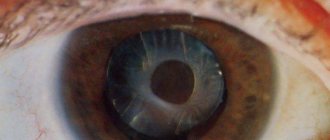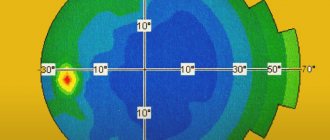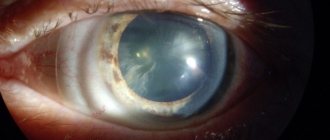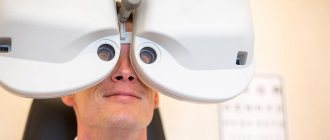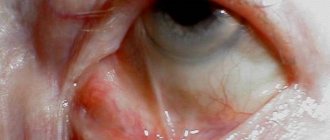What is glaucoma
Glaucoma is a disease that humanity has known about for a very long time. The ancient Greek healer Hippocrates mentioned it in his works. In the process of the development of medicine, more and more information about pathology became available, more than one classification was compiled according to various criteria, and more than one myth about the peculiarities of its course and methods of treatment was debunked. Therefore, it will not be difficult for a specialist to make the correct diagnosis.
The disease develops as a result of increased pressure in the organ (intraocular pressure) and leads to irreversible consequences - loss of vision. There are two forms of pathology:
- Closed angle: the anterior chamber of the eye (its angle) is closed by the peripheral part of the iris.
- Open-angle: form - a form that occurs as a result of a malfunction of the drainage system (responsible for normal moisture circulation).
The most common is open-angle glaucoma (about 80% of cases). The danger of the pathology lies in the absence of symptoms. The patient may notice discomfort already in the last stages of the disease.
How is glaucoma treated?
If glaucoma is diagnosed early, there is a good chance of stopping the progression of the disease and saving your vision. However, it should be remembered that this is not a curable disease. Decreased vision, once it has occurred, cannot be reversed. Depending on the severity, various pharmacological agents (eye drops and tablets) are used to reduce intraocular pressure. In cases where treatment with drops and tablets does not produce results or causes side effects, laser treatment is successfully used. Sometimes a regular, specialized surgical procedure is necessary. It is most often performed on an outpatient basis under local anesthesia, without the need to be in the hospital.
What is cataract
Cataract is a disease in which the lens is damaged. The lens performs important functions: light refraction, accommodation, light transmission, protective and separation functions. With cataracts, clouding of this biological lens is observed and, accordingly, vision deteriorates.
The disease can be congenital or acquired, but unlike glaucoma, it is easily treatable. Depending on the location of the pathological process, the following forms of cataract are distinguished:
- subcapsular;
- nuclear;
- cortical;
- mixed.
The disease can be either congenital or acquired. But the main number of cases is the detection of pathology in people over 40 years of age.
Features of diseases
To understand how to distinguish cataracts from glaucoma, you need to understand the specifics of the diseases and the causes of their occurrence. Both diseases are closely related, since due to clouding and enlargement of the lens with cataracts, glaucoma can develop.
Glaucoma develops in patients with increased intraocular pressure, cardiovascular diseases, and low blood pressure. With glaucoma, the outflow of intraocular fluid is disrupted. At the same time, blood supply deteriorates, pressure on the optic nerve increases, which is why it gradually atrophies. Specific symptoms of glaucoma:
- painful sensations in the eyes and tension;
- gradual narrowing of the field of view;
- redness of the eyes;
- pain in the area around the eyes.
Cataracts develop as a result of metabolic disorders and age-related changes. Gradually, the protein structure of the lens becomes cloudy, which causes vision deterioration. Specific symptoms of cataracts are:
- change in pupil color from slightly grayish to milky white;
- blur and ghosting of the image;
- loss of color brightness;
- sensitivity to sunlight.
General symptoms
- Both diseases are more common in older patients after 70 years of age, but can also be congenital.
- Patients with diabetes and endocrine diseases, as well as high myopia, are at risk.
- Diseases are constantly progressing.
- Patients experience fog before their eyes;
- There is a deterioration in visual acuity at dusk in low light conditions.
- The appearance of glare and halos around brightly lit objects is observed.
Differences
| Glaucoma | Cataract |
| Glaucoma develops due to increased intraocular pressure, which causes gradual atrophy of the optic nerve. | Cataracts occur due to metabolic disorders that cause clouding of the lens. |
| In glaucoma, vision loss is irreversible and visual function is not restored. | For cataracts, vision loss due to clouding of the lens can be restored by replacing an artificial lens. |
| Medicines are used as maintenance therapy | Only surgery is effective |
| Possible acute attack | The disease develops gradually |
| There is still a possibility of relapse even after surgical treatment | Cataracts do not develop again |
Symptoms of pathologies
Glaucoma, like cataracts, occurs in 4 stages. Each of them is characterized by certain symptoms. The insidiousness of these pathologies lies in the hidden course in the early stages, and already in the last stages, vision is completely lost. Despite the fact that only a doctor can detect both diseases in the initial stages during an examination using special equipment, there are a number of obvious symptoms that are the reason for a mandatory visit to an ophthalmologist.
A list of the main signs of glaucoma in the early stages and in the last stages that should alert you:
- vision becomes blurred, a grid and (or) rainbow circles appear before the eyes when looking at a glowing light bulb for a short or long time;
- discomfort occurs, pain and pain appear in the eyes;
- eye(s) are excessively moist.
Main symptoms of cataracts:
- objects become blurry or begin to appear double;
- Contrast decreases and color perception deteriorates;
- suddenly the patient develops spots or spots before the eyes;
- the color of the pupil changes (becomes white);
- photosensitivity appears.
It should also be noted that a common symptom of cataracts and glaucoma of the eye is a characteristic deterioration in vision, which is observed precisely in the evening.
Cataract as a consequence of glaucoma
Cataracts as a consequence of glaucoma can occur as a result of the lens of the eye becoming cloudy, swelling and increasing in size. Sometimes this can be accompanied by an increase in intraocular pressure, that is, glaucoma.
Both of these diseases can be present at the same time, but their severity will be different. For example, if a person has high-grade cataracts, then glaucoma will be in the early stages. And if glaucoma is severe, then cataracts will be at an initial stage.
Causes of diseases
It has been proven that cataracts and glaucoma are predominantly a disease of older people, therefore age-related changes play a dominant role in determining the causes of these pathologies. But it is also known that glaucoma and cataracts can occur at any age, so there are a number of other provoking factors for the development of these diseases.
Causes of glaucoma (risk factors):
- heredity;
- belonging to a certain race (among Africans this disease occurs many times more often than, for example, among Asians);
- history of trauma;
- myopia;
- increased pressure (intraocular);
- farsightedness;
- thinner cornea;
- long-term and (or) uncontrolled use of steroids, etc.
Causes of cataract development:
- heredity;
- bad habits;
- poor nutrition;
- bad ecology;
- injuries;
- radiation;
- hypertension;
- diabetes;
- eye diseases (myopia, glaucoma, etc.);
- infections transmitted to a newborn from the mother during labor.
It is very important to identify and eliminate (if possible) provoking factors in a timely manner. Failure to take any action on the part of the patient risks loss of vision.
What treatment is prescribed?
Complex therapy
At the initial stages of development, treatment of glaucoma is conservative. Medicines that normalize the circulation of intraocular fluid, as well as medications that inhibit the production of aqueous humor, help prevent the progression of the disease and restore visual function. Vitamins and dietary supplements are required to strengthen visual structures.
If the cataract does not progress, a specialist may prescribe drug treatment without surgery.
Doctors have different opinions about cataracts and how to treat them. Since medications are unable to completely cure the disease, as long as it is not complicated, the doctor may recommend surgical treatment. However, when the disease does not progress, surgery is not performed, but the following groups of drugs are prescribed:
- normalizing electrolyte metabolism, which helps reduce lens dehydration;
- improving metabolism in intraocular structures;
- restoring oxidative processes in the lens.
When is surgery necessary?
The more advanced the disease, the more dangerous it is for the patient’s health, so removal of cataracts and glaucoma is prescribed in extreme cases, if there is no effect from conservative methods. If the diseases occur simultaneously, eye surgery will be required in several stages. This procedure is dangerous and is often accompanied by complications, and the rehabilitation period also extends over time, which negatively affects the emotional state of the patient. The sequence of surgery for cataracts and glaucoma is as follows:
- The deformed lens is removed.
- An operation is performed to normalize the outflow of intraocular fluid. The following types of surgery can be performed: canaloplasty;
- trabeculectomy;
- laser correction;
- installation of a shunt tube or valve implant.
Restrictions
During pregnancy, you cannot undergo surgery to remove pathologies, since such an event requires more than one approach and has a long rehabilitation period.
However, not all patients are allowed to undergo such an operation, as it is considered complex. Contraindications to surgery are:
- complete atrophy of the optic nerve;
- acute infectious process in the body;
- progressive systemic diseases, oncology;
- neurological pathologies;
- pregnancy and breastfeeding.
Rehabilitation
After removal of glaucoma and cataracts, rehabilitation is necessary. To prevent postoperative complications, restorative drug therapy, special exercises, and diet are prescribed. In the first days after surgery, it is forbidden to wash your face, watch TV for a long time, go outside without sunglasses, use decorative cosmetics, or visit the sauna, bathhouse, or swimming pool.
To make recovery after surgery faster, it is important to monitor your diet. Special orange foods - apricot, orange, carrot, pumpkin - will help strengthen the visual system and prevent the condition from reaching a complicated stage.
Folk remedies
To improve blood circulation and nutrition of intraocular structures, it is recommended to apply cold compresses to the eyelids, the basis for which can be prepared according to this recipe:
Lotions made from infusions of nettle and lily of the valley have a beneficial effect on blood circulation in the visual system.
- Pour 250 ml of boiling water ½ tbsp. nettle leaves and 1 tbsp. l. dried lily of the valley flowers.
- Cover the container with a lid and leave to infuse overnight.
- In the morning, strain the product and add another 1 tsp. baking soda, mix well.
- Soak cotton pads in the liquid and apply to the eyes for 15-20 minutes.
Hot foot baths stimulate the drainage system well. The method of application is:
- Pour hot water into a bowl, add 3 tbsp. l. sea salt and dilute it.
- Immerse your feet in the solution and take a bath for 25 minutes. If the water cools down, you can add hot water. It is recommended to maintain a stable temperature.
Diagnostics
In order to make an accurate diagnosis and determine the stage of glaucoma, the ophthalmologist needs to carry out a number of the following diagnostic measures:
- measuring eye pressure using special devices (tonometer and elastomometer);
- checking visual acuity using a specially designed Sivtsev table;
- checking the condition of the fundus using an ophthalmoscope;
- using tonography to check fluid outflow indicators;
- conducting an ophthalmological examination such as perimetry (it helps to determine the boundaries of the visual field).
A biomicroscope is used to detect cataracts in children and adults. The diagnostic procedure helps determine the presence of pathological processes and is absolutely painless.
Glaucoma treatment and diet
A proper diet can delay the progression of the disease and minimize its symptoms. Let's look at what should be included in the menu and what is better to limit.
Decreased insulin levels
Avoid eating excessive amounts of sugars and other foods that raise blood sugar levels and consequently increase insulin levels. To stop the progression of glaucoma, limit your consumption of pasta, bread, white rice, potatoes and sweets.
Provide your body with lutein
Lutein is one of the most popular natural antioxidants. Our eyes act as a filter that protects against the harmful effects of ultraviolet rays. Most lutein is found in fish, green vegetables (green and Italian cabbage, broccoli), cereal sprouts, chicken eggs, parsley, nectarines, black currants and avocados.
Eat blueberries
These invisible fruits have a great impact on memory, concentration and, above all, vision. Due to their high anthocyanin content, blueberries strengthen the capillaries in the eye, making it better nourished and supplied with blood.
Limit your fat intake
Eating too much animal fat contributes to macular degeneration. In addition, they interfere with the absorption of omega-3 fatty acids, which are the building blocks of nervous tissue, including those found in the retina, and photoreceptors.
Vitamin of youth
Vitamin E has the greatest antioxidant properties. It protects the body from the harmful effects of free radicals, which cause the death of cells that form ocular tissue. Vitamin E is found in large quantities in vegetable oils, as well as in almonds, margarine, eggs, carrots, milk, Brussels sprouts, nuts, wheat germ and green vegetables.
Conclusion
Look is one of our most valuable senses. Our lifestyle, diet, prevention and genes determine how long we will enjoy healthy eyes. Glaucoma and cataracts are two of the most common eye diseases today. If left untreated, they lead to significant visual impairment or complete loss of vision.
What is the difference between cataract and glaucoma?
For a long time, cataracts and glaucoma were not separate diseases and no differences were observed between them. This is not surprising, since both pathologies lead to visual impairment or blindness and are more common among older people. But, despite all of the above, the difference between these diseases is still significant and is as follows:
- localization of pathological processes: with cataracts, the lens is affected, with glaucoma - the entire eye;
- differences in treatment methods used;
- the likelihood of vision restoration: glaucoma leads to blindness, cataracts are treatable.
What is the difference between lens replacement diseases - glaucoma and cataracts?
Differences between lens replacement diseases - glaucoma and cataracts.
Both diseases more often bother older people. Despite the similarity of symptoms, these ailments differ from each other. Here's how lens replacement diseases differ from each other - glaucoma, cataracts:
- The appearance of cataracts is caused by the lens, which has lost its original transparency.
- With glaucoma, more complex changes occur in the structure of the eye.
- Glaucoma develops due to fluid stagnation in the eyeball. Excess fluid puts pressure on the optic nerve, slowly destroying it. Over time, the disease leads to nerve atrophy and completely deprives a person of vision.
A few more differences:
- Impaired fluid drainage associated with glaucoma damages all structures of the eye.
- Cataracts affect only certain fragments of the organ of vision. This pathology allows us to hope for healing. After all, after replacing the lens with a synthetic analogue, vision is completely restored.
Glaucoma is not easy to treat. Doctors use various methods to slow down the destructive processes occurring in the eyes. However, they cannot restore vision if the nerve has already been destroyed.
Treatment methods for cataracts and glaucoma
The main task of doctors in the treatment of glaucoma is to normalize intraocular pressure. Methods of treating the disease:
- medicinal (medicines are prescribed individually and are used to reduce the production or improve the outflow of fluid inside the eye);
- laser treatment (not equally effective for different forms of the disease, the main advantage is that it is used at any stage);
- surgical intervention (is the most effective method of treatment at any stage of the disease, but requires careful preparation: selection of the type of surgical intervention, diagnosis, etc.).
There are a large number of different traditional methods for treating glaucoma posted online, but their effectiveness has not been confirmed. Self-medication is extremely dangerous to health and leads to irreversible consequences, as precious time is lost.
The most effective method of treating cataracts today is surgery, during which the affected lens is replaced with an artificial lens.
The operation can also be performed using a laser (to divide the lens into small pieces). This method is the most effective and safe, but the cost of the procedure increases significantly.
During treatment, anti-catarrhal drops with taurine or azapentacene may be prescribed, but many ophthalmologists question the effectiveness of such drugs for cataracts.
What's worse: glaucoma or cataracts?
Doctors believe that the development of glaucoma is much worse. This is due to the fact that, if left untreated, uncontrolled growth of the chambers leads to intraocular bleeding. The optic nerve and retina atrophy, so the function of the eyeballs is completely disabled. It's beyond reclaim.
Cataracts can be eliminated at any stage. But if the disease has reached irreparable degenerative forms, it is not curable. Thanks to surgical treatment, it is possible to introduce multifocal lenses that are capable of accommodating the eyes.
That is, the patient’s vision will be one hundred percent, he will be able to see far and near.
How diseases manifest themselves
The signs of glaucoma and cataracts can also be different. As a rule, the first develops very slowly, even over several decades. In the early stages, the disease almost never has clear symptoms. In 90% of cases, the pathology occurs in the so-called open-angle form. The field of view in this case narrows gradually. Sometimes, quite by accident, a person notices that he can see with only one eye. Other symptoms include:
- “fogging,” that is, the feeling of a smoky or foggy block in front of the eyes;
- the appearance of circles when contemplating objects of illumination;
- rapid visual fatigue, even if the person did not work at the computer and slept normally.
Degrees and nature of vision changes
In another 10% of cases, a closed-angle form develops. In this case, the first signs are more clear. These include:
- sharp pain not only in the eye, but also in a certain part of the head (the one where the clouding is located);
- the appearance of disease-specific halos when the patient looks at the light;
- sharp deterioration of vision (up to complete blindness);
- redness of the eye;
- strong pupil dilation;
- lack of pupil reaction to light.
The symptoms of cataracts are completely different and very varied. These include the following:
- inability to recognize color;
- double vision;
- sensitivity to light;
- myopia;
- blurred vision;
- fog before the eyes.
Stages of cataract development
For a long time, the disease may not differ in any manifestations if cataracts form in the peripheral zone. In this case, the patient turns to the doctor late, when his vision has deteriorated greatly. Another difference lies in the fact that with cataracts a person reads poorly and is not able to perform precise work, so performing professional duties becomes impossible.
Sometimes cataracts can be congenital or occur in childhood. In this case, parents may notice a change in the color of the lens from black to white. In some cases, a child may become completely blind, because the lens may be so cloudy that it does not transmit light at all.
